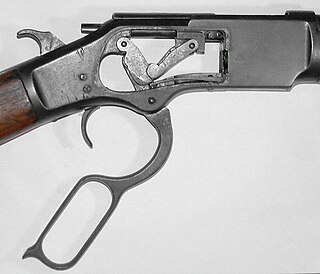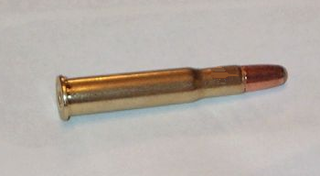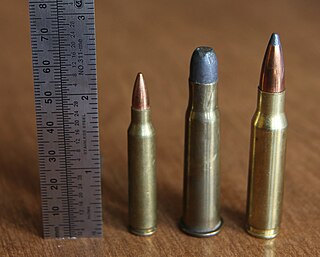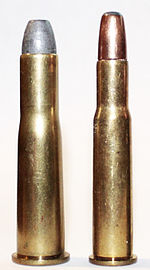Winchester rifle is a comprehensive term describing a series of lever action repeating rifles manufactured by the Winchester Repeating Arms Company. Developed from the 1860 Henry rifle, Winchester rifles were among the earliest repeaters. The Model 1873 was particularly successful, being marketed by the manufacturer as "The Gun That Won the West".

A lever action is a type of action for repeating firearms that uses a manually operated cocking handle located around the trigger guard area that pivots forward to move the bolt via internal linkages, which will feed and extract cartridges into and out of the chamber, and cock the firing pin mechanism. This contrasts to other type of repeating actions such as the bolt-action, pump-action, semi-automatic, fully automatic, and/or burst mode actions. A firearm using this operating mechanism is colloquially referred to as a levergun.

The .44 Remington Magnum, also known as .44 Magnum or 10.9x33mmR, is a rimmed, large-bore cartridge originally designed for revolvers and quickly adopted for carbines and rifles. Despite the ".44" designation, guns chambered for the .44 Magnum round, its parent case, the .44 Special, and its parent case, the .44 Russian all use 0.429 in (10.9 mm) diameter bullets. The .44 Magnum is based on the .44 Special case but lengthened and loaded to higher pressures for greater velocity and energy.

The .38-40 Winchester (10.17x33mmR) is actually a .40 caliber (10 mm) cartridge shooting .401 in (10.2 mm) caliber bullets. The cartridge was introduced by Winchester in 1874 and is derived from their .44-40 Winchester. This cartridge was introduced for rifles, but in its reintroduction for cowboy action shooting it has seen some popularity as a revolver cartridge. It is not particularly well suited to hunting larger game, but it was popular when it was introduced, along with the previous .44-40 Winchester, for deer hunting. It can be used successfully on smaller game animals, and for self-defense. Current loadings are intended for revolvers.
The Winchester Repeating Arms Company was a prominent American manufacturer of repeating firearms and ammunition. The firm was established in 1866 by Oliver Winchester and was located in New Haven, Connecticut. The firm went into receivership in 1931 and was bought by the Western Cartridge Company, a forerunner of the Olin Corporation. The Winchester brand name is still owned by the Olin Corporation, which makes ammunition under that name. The Winchester name is also used under license for firearms produced by two subsidiaries of the Herstal Group – FN Herstal of Belgium and the Browning Arms Company of Ogden, Utah.

The .30-30 Winchester cartridge was first marketed for the Winchester Model 1894 lever-action rifle in 1895. The .30-30, as it is most commonly known, along with the .25-35 Winchester, was offered that year as the United States' first small-bore sporting rifle cartridges designed for smokeless powder. Since its introduction, it has been utilized alongside the development of flatter shooting cartridges, most prominently those derived from designs subsidized by interest in military expenditures, yet the .30-30 has remained in widespread use almost entirely because of reliable effectiveness in civilian applications, proven by putting food on the table for millions of people within a practical range of hunting situations.
The Winchester Model 71 was a lever-action rifle introduced in 1935 and discontinued in 1958.
The Winchester Model 1894 rifle is a lever-action repeating rifle that became one of the most famous and popular hunting rifles of all time. It was designed by John Browning in 1894 and originally chambered to fire two metallic black powder cartridges, the .32-40 Winchester and .38-55 Winchester. It was the first rifle to chamber the smokeless powder round, the .30 WCF in 1895. In 1901, Winchester created the new .32 Winchester Special caliber with production of rifles starting in 1902.

The Winchester Model 1892 was a lever-action repeating rifle designed by John Browning as a smaller, lighter version of his large-frame Model 1886, and which replaced the Model 1873 as the company's lever-action for pistol-caliber rounds such as the .44-40.

The Marlin Model 1894 is a lever-action repeating rifle introduced in 1894 by the Marlin Firearms Company of North Haven, Connecticut. At its introduction the rifle came with a 24-inch barrel and was chambered for a variety of rounds such as .25-20 Winchester, .32-20 Winchester, .38-40, and .44-40. Variants in other chamberings remain in production today.
The .405 Winchester is a rimmed centerfire rifle cartridge introduced in 1904 for the Winchester 1895 lever-action rifle. It remains to this day one of the most powerful rimmed cartridge designed specifically for lever-action rifles; the only modern lever action cartridges that exceed its performance are the .50 Alaskan, .450 Alaskan, .475 Turnbull, .348 Turnbull, and the .450 Marlin. The .405 was highly regarded by U.S. President Theodore Roosevelt during his safari in East Africa.

The .38-55 Winchester cartridge, also known as the .38-55 WCF and the .38-55 Ballard, is a centerfire rifle cartridge. It was based on an earlier cartridge called the .38-50 Ballard Everlasting that was introduced in 1876 by the Ballard Rifle & Cartridge Company. The .38-55 was used in Marlin Firearms from 1876 onwards for various single-shot target rifles and their 1893 lever-action rifle. It was later offered by Winchester in its Model 1894. Winchester continued to use the round in various rifles until about 1940, and also used it in a few commemorative editions of rifles since then. In addition, Marlin offered it in some 336s, and it was used in non-lever action rifles such as the Remington-Lee bolt-action. The .38-55 Winchester is also the parent case for the .30-30 Winchester, .32 Winchester Special, and the .375 Winchester cartridges.

The .33 Winchester Center Fire is a centerfire rifle cartridge designed and produced from 1902 to 1940 by Winchester Repeating Arms Company for their Model 1886 lever-action rifle.
The .50-110 WCF in modern 1886 Winchesters with modern steel barrels is the most powerful lever-action cartridge, with up to 6,000 foot-pounds (8,100 J) of energy.
The Winchester Model 1886 was a lever-action repeating rifle designed by John Browning to handle some of the more powerful cartridges of the period. Originally chambered in .45-70 Government, .45-90 Sharps, and .40-82 Winchester, it was later offered in a half dozen other large cartridges, including the .50-110 Winchester. Despite being originally designed for use with black powder, the action was strong enough to make the jump to smokeless powder with only minor modifications, and was subsequently chambered in the smokeless .33 Winchester cartridge beginning in 1903.

The .50 Alaskan is a wildcat cartridge developed by Harold Johnson and Harold Fuller of the Kenai Peninsula of Alaska in the 1950s. Johnson based the cartridge on the .348 Winchester in order to create a rifle capable of handling the large bears in Alaska.
The .38-72 Winchester, also known as .38-72 WCF is a rimmed, bottleneck centerfire rifle cartridge introduced in 1895 for the Winchester 1895 lever-action rifle.

The .45-75 WinchesterCentennial is a centerfire rifle cartridge developed in 1876 for the newly designed Winchester Model 1876 Centennial lever-action rifle. Winchester Repeating Arms Company introduced the rifle and cartridge at the United States Centennial Exposition. The Model 1876 rifle used an enlarged version of the famous Winchester Model 1873 action to offer a lever-action repeating rifle using cartridges suitable for big-game hunting. The cartridge and rifle enjoyed brief popularity with Gilded Age American hunters including Theodore Roosevelt, and was issued to the Canadian North-West Mounted Police and to Texas Rangers.

The .45-60 Winchester is a centerfire rifle cartridge intended for 19th-century big-game hunting. Nomenclature of the era indicated the .45-60 cartridge contained a 0.45-inch (11.43 mm) diameter bullet with 60 grains (3.89 g) of black powder. Winchester Repeating Arms Company shortened the .45-70 Government cartridge to operate through the Winchester Model 1876 rifle's lever-action.

The .40-60 Winchester is a rimmed, bottlenecked centerfire rifle cartridge designed for use in lever-action rifles by Winchester Repeating Arms Company in 1884.













